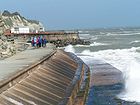- Dolos
-
For the Gundam ship, see Dolos class.
 Dolosse - Cape Town, South Africa
Dolosse - Cape Town, South Africa
A dolos (plural dolosse) is a concrete block in a complex geometric shape weighing up to 20 tons, used in great numbers to protect harbour walls from the erosive force of ocean waves. They were developed in East London, a port city in South Africa, in 1963 and are found in millions around the world.
Contents
Construction
 Dolos construction yard - Yzerfontein, South Africa
Dolos construction yard - Yzerfontein, South Africa
 A man stands next to a dolos, showing its relative size. Dolosse moulds are in the foreground - Durban, South Africa
A man stands next to a dolos, showing its relative size. Dolosse moulds are in the foreground - Durban, South Africa
Dolosse are normally made from un-reinforced concrete, poured into a steel mould. The concrete will sometimes be mixed with small steel fibers, to strengthen it in the absence of reinforcing. Construction is done as close as possible to the area of application as a result of their great weight.
Use
They are used to protect harbour walls, breakwaters, and shore earthworks. They are also used to bind sea-sand to prevent erosion. In the order of 10 000 dolosse are required for a kilometre of coastline.
They work by dissipating, rather than blocking, the energy of waves. Their design deflects most wave action energy to the side, making them more difficult to dislodge than objects of a similar weight presenting a flat surface. Though they are placed into position on top of each other by cranes, over time, they tend to get further entangled as the waves shift them. Their design ensures that they form an interlocking, but porous, wall.
They are often numbered so that satellites can track their movement. This helps engineers gauge whether they need to add more dolosse to the pile.
Credit for invention
Their design is usually credited to the South African Eric Mowbray Merrifield, one-time East London Harbour Engineer (from 1961–1976). In the late 1990s the claim of Mr Aubrey Kruger gained more prominence. Kruger's claim is that he and Merrifield had considered the shape of concrete blocks to be used to protect East London's extensive breakwaters for the City's non-natural harbour, following a major storm in 1963. Merrifield wished to design a block that did not break up or shift when struck by the sea; that was cheap; and that did not require precise placement. He said in later years that he wanted a block designed in such a way that it could be "sprinkled like children's jacks". Kruger stated that he went home for lunch, cut three sections from a broomstick, and fastened them with nails into an H-shape with one leg turned through 90 degrees to create the distinctive dolos shape. Merrifield was intrigued by the object and had Kruger draw a plan. Kruger never formally received credit for the invention. Merrifield won the Shell Design Award and the Associated Science and Technology Societies of South Africa's Gold Medal. The death of Merrifield (in 1982) has put this controversy beyond proof either way.
Design protection
Unusually, their design is not subject to design protection, Merrifield not having taken the necessary steps to protect them.
The reason for this is also uncertain as two reasons for this failure have been put forward: one by Merrifield; the other by Kruger. Merrifield stated that he did not protect them as he wished them to benefit humanity. Kruger alleges that Merrifield received incorrect legal advice that as they were designed in office hours while employed by the state (South African Railways and Harbours Administration) he was unable to protect their design.
Origin of name
Their name is derived from the Afrikaans word dolosse. This word has two given derivations. Rosenthal states it to be a contraction of 'dobbel osse', or 'gambling' (Afrikaans) 'bones' (Latin). Boshof and Nienaber state it to be a contraction of 'dollen os', or 'play' (old Dutch) 'oxen' (Afrikaans). The first is a meaning-shifted reference to ox knuckle-joint bones used in divination practices by sangomas, Southern African traditional healers. They somewhat resemble these bones. The second is a reference to ox or lamb knuckle bones used by African children at play. The name was attached to the objects when Kruger's father, Joe Kruger, who also worked in the harbour, came upon his son and others playing with small models of the objects and asked him Wat speel julle met die dolos? (English: What are you playing at with the dolos?).
References
- Eastern Cape Dispatch, 28 June 1999
- Martin Creamer's Engineering News, 16 February 2001
- South African Financial Mail, 3 December 2004
- John McPhee, Giving Good Weight, "The Atlantic Generating Station", Macfarlane Walter and Ross, 1975, ISBN 0-374-51600-6
- Encyclopaedia of Southern Africa, Eric Rosenthal, Frederick Warne and Co. Ltd, London and New York, 1961, definition of 'dolos' (published prior to the invention of the subject of this article)
See also
Humboldt Bay - jetties were reinforced using dolos in the 1980s maintaining the entrance at one of the world's most treacherous harbor entrances.
Management - Coastal management
- Accretion
- Coastal engineering
- Integrated coastal zone management
- Managed retreat
- Submersion

Hard engineering Soft engineering - Beach nourishment
- Beach drainage
- Sand dune stabilization
- Soft engineering
- Soft shore remediation
Related topics - Beach evolution
- Coastal erosion
- Land reclamation
- Longshore transport
- Modern recession of beaches
Categories:- Coastal engineering
- Marine revetment
Wikimedia Foundation. 2010.

